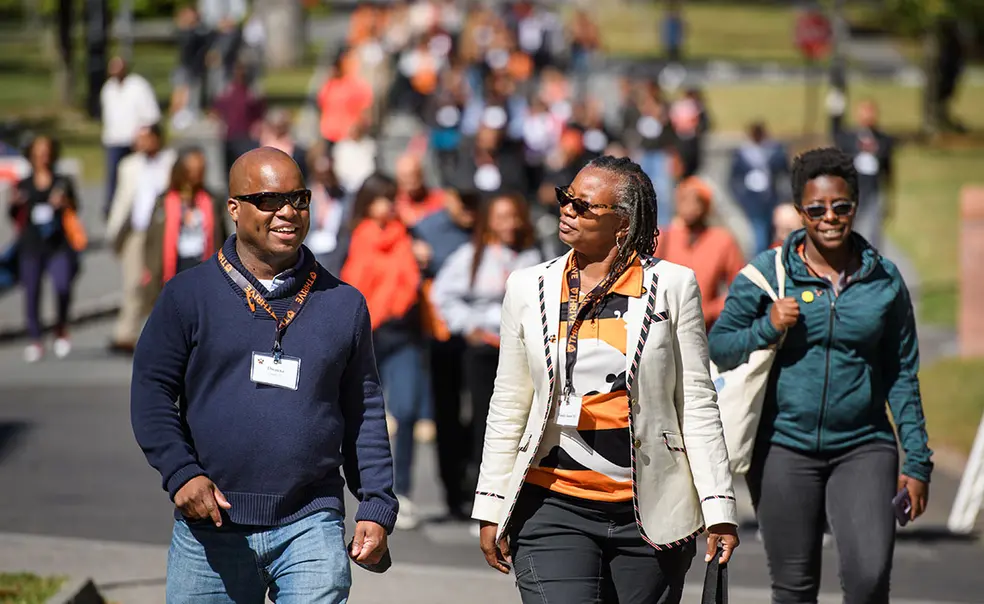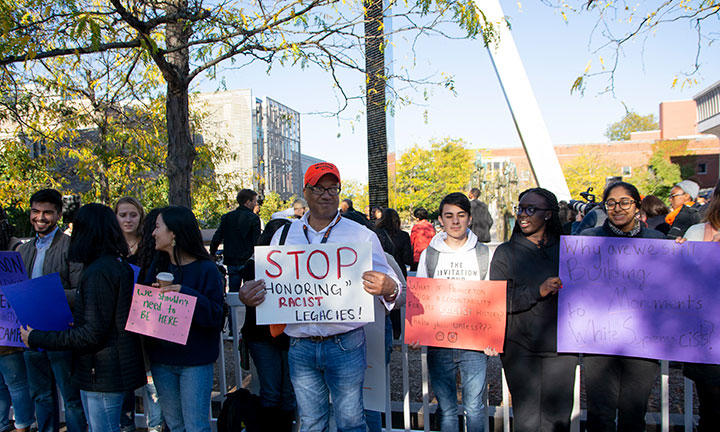Thrive Conference Features Thought-Provoking Conversations, Opportunities to Connect
Moments of laughter, joy, reflection, and pain punctuated Thrive: Empowering and Celebrating Princeton’s Black Alumni, a conference on campus Oct. 3-5. The three-day gathering featured educational sessions, thought-provoking dialogue, and opportunities for black alumni to connect across generations.
More than 1,200 participants attended the conference, the University’s fourth conference for black alumni. Although they hail from different classes, many bonded over their shared experience of being black at Princeton. Still, many alumni proudly donned orange hats, pants, nail polish, and sneakers.
As Franne McNeal ’82 put it, “This is our Reunions.”
“I’m thrilled to be here with all of you,” said Karen Richardson ’93, who started work in admissions as a work-study student and became dean of admission in July. “Welcome back, my friends.” She encouraged the alumni not only to reflect on their time at Princeton, but to pay it forward by connecting with current students.
President Eisgruber ’83 updated attendees on some of the projects and initiatives taking place at the University. Michael S. Fletcher II ’03, president of the Association of Black Princeton Alumni, said he was heartened by “how many people are coming back for the first time and how many are returning to continue your journey through Princeton.”
The busy schedule included more than 200 participants in more than 60 events on topics that ranged from entrepreneurship and sports to media representation and history.
On one panel, Eddie S. Glaude Jr. *97, chair of African American studies, thanked the alumni for their impact in establishing the department. “In a short period of time, your voices and your demands made it possible for us to go from a center to a department,” he said.
But Glaude, who read from his forthcoming book about James Baldwin, made clear that much work remains to be done – both at the national level and at Princeton itself. “As you see this place transformed – don’t believe it. We have a long way to go,” he said. “Princeton stands on the precipice of profound change,” he continued. “We must push it to tell a different story of itself – one that expresses your presence. Princeton desperately needs you to help it become what it aspires to be.”
The complex history of African Americans on Princeton’s campus was front and center on Saturday with the dedication of “Double Sights,” a 39-foot-high sculpture on Scudder Plaza adjacent to the Woodrow Wilson School of Public and International Affairs.
The installation, designed by 2019 MacArthur recipient Walter Hood, was created on the recommendation of a University trustees committee that studied Woodrow Wilson’s legacy at Princeton. The committee was assembled to address concerns raised in 2015 by the Black Justice League, a student group, about how the University has recognized Wilson, because of his history of racism. The students had called for changing the name of the Woodrow Wilson School.
Hood and vice provost Michele Minter conducted a public conversation about the sculpture during a session in McCosh 50 titled “Woodrow Wilson’s Legacy: Wrestling with History” that included some tense exchanges with audience members. Some who spoke questioned the marker’s purpose, arguing that it stands as a monument to Wilson.
Brent L. Henry ’69, vice chair of the University’s board of trustees, reiterated how the marker came to be: “We decided that on balance, rather than erase [Wilson’s] name from Princeton, that we should preserve it but also explain it,” Henry said. “And that’s what we’re doing today.”
Following the conversation, Eisgruber and Cecilia Rouse, dean of the Woodrow Wilson School, spoke during the sculpture’s dedication while protesters holding signs expressed their disapproval in a silent protest.
Many conference-goers did not sugarcoat their experience on Princeton’s campus. Often when someone recalled their own unpleasant experiences at Princeton, the alum mentioned how others refuse to return for events as a result of their own struggles on campus. Still, alumni consistently voiced their pride to be part of Princeton’s approximately 5,800 black alumni.
“To me, Thrive represents progression in a series of conversations between the University and black students, and so I’ve appreciated that,” said Hilary Beard ’84. “It’s been important to me that the University has acknowledged and apologized for the harm that too many black students and students of color have experienced.”
For Kezia Otinkorang ’20, it was empowering to see so many successful black alumni. “It means a lot to me to see so many black alumni back on campus,” she said. “Their joyful expressions, genuine interest in current students, and great faith in all of us meant the world to me and my peers. It gives us a glimpse into what black excellence and solidarity look like.”
While the experience comes with peaks and valleys, attending Princeton gives students an opportunity to change their lives, said Rep. Terri Sewell ’86, during her remarks at Thrive’s closing event. “While we all have individual successes, and all of us do, we collectively thrive because of our strength in numbers and our strength in support.”












No responses yet